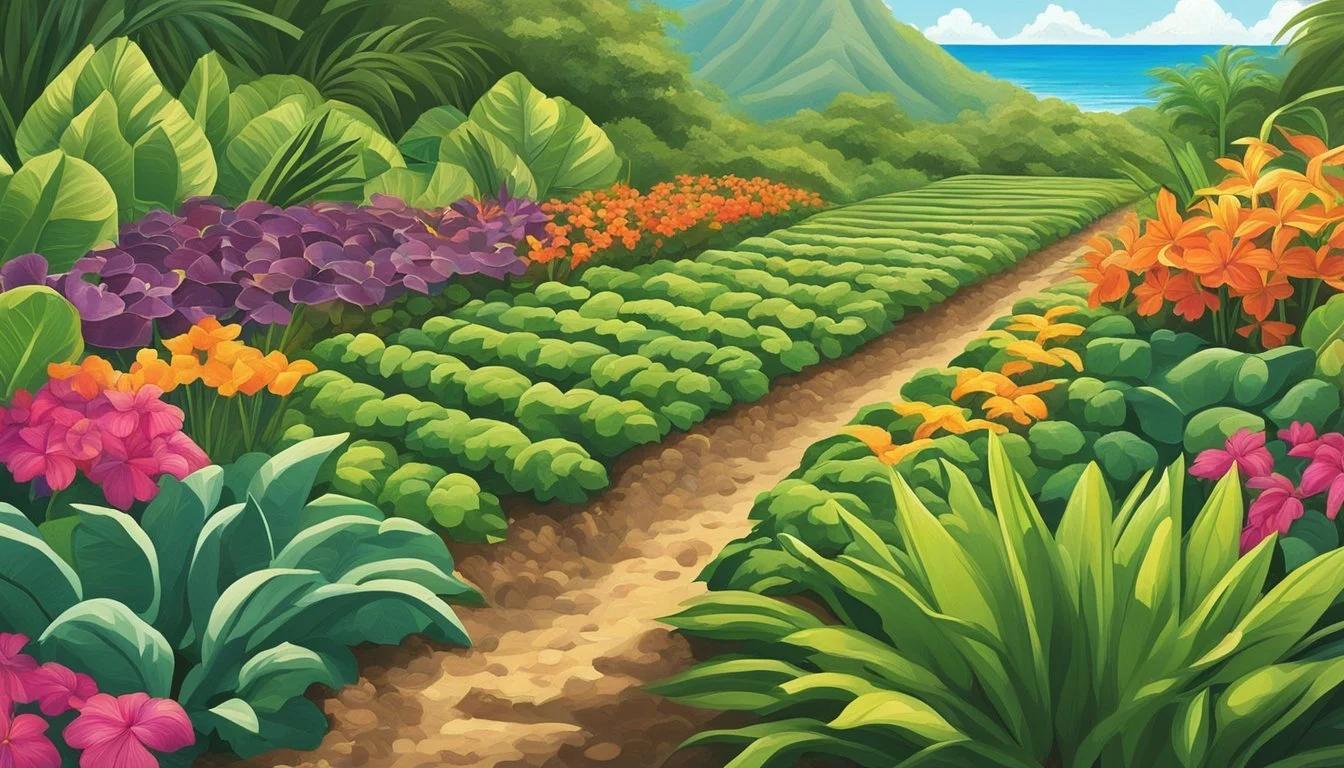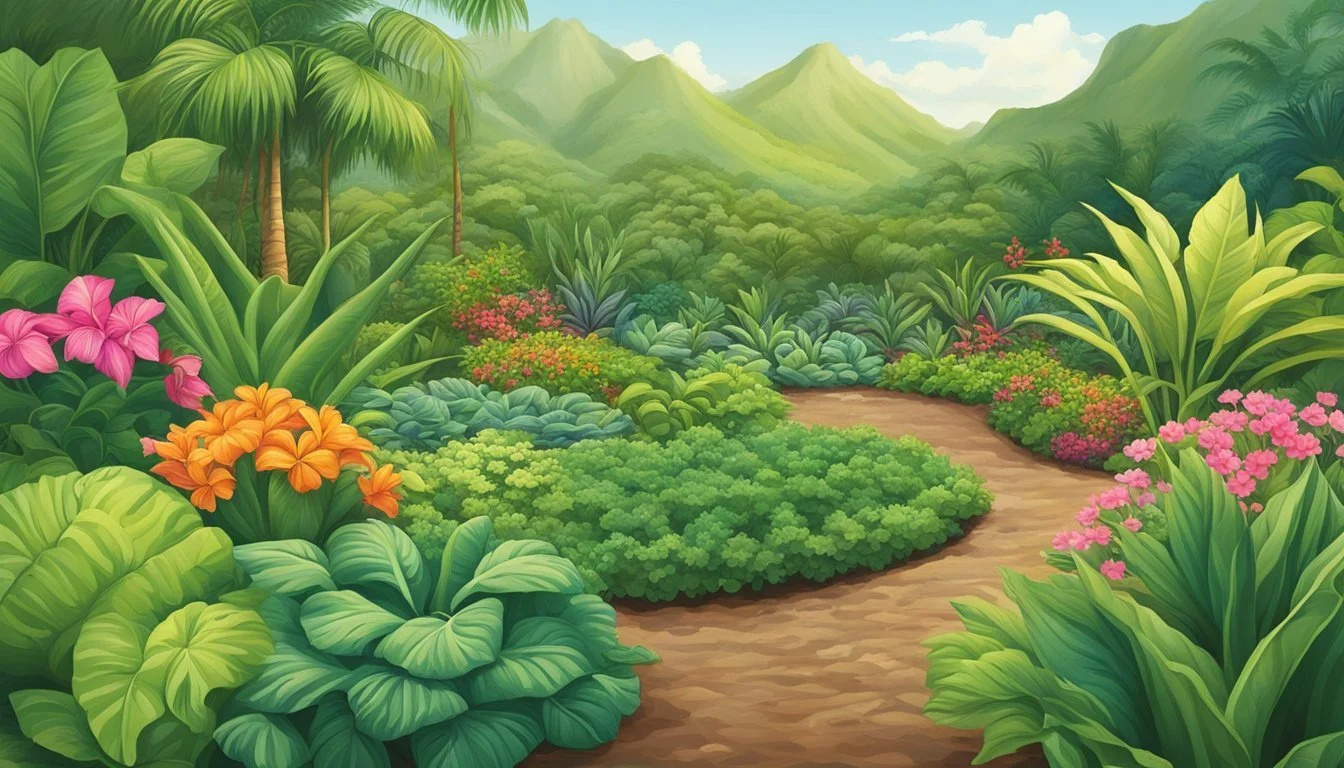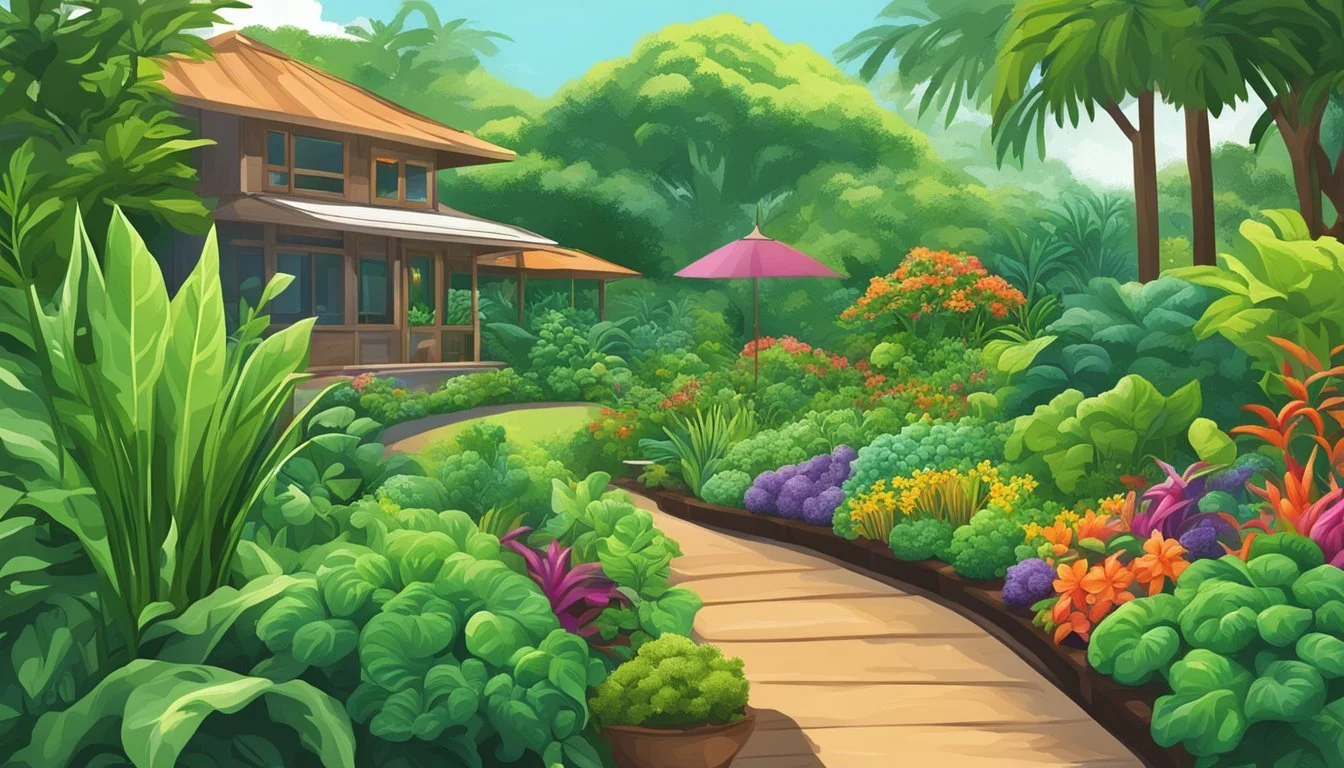Vegetable Gardening in Hawaii
Essential Tips for a Tropical Eden
This Article is Part of Our Guide on Vegetable Gardening by State
Vegetable gardening in Hawaii presents unique opportunities and challenges due to its tropical climate and volcanic soil. The year-round warm temperatures and rich earth provide optimal conditions for a variety of vegetables to thrive. However, careful selection of crops is essential, as traditional cool-season vegetables may struggle in the persistent heat. Gardeners in Hawaii often find success planting arugula (how long does arugula last?), basil (how long does basil last?), cantaloupe (how long does cantaloupe last?), and carrots, which are well-suited to the local conditions.
In contrast to the cooler climates of the mainland, Hawaiian gardeners have the advantage of being able to grow certain crops throughout the year. Local practices and wisdom guide the cultivation of taro, eggplant (What wine goes well with eggplant?), okra, beans, spinach, and lettuce among other produce which have been adapted to the island’s unique environment. Awareness of local issues is important, such as the Rat Lung Worm Disease, which is a concern for crops like lettuce that are consumed raw. Proper gardening techniques and plant choices can mitigate such risks.
The diversity of Hawaii’s microclimates also allows for specialized gardening in different regions of the islands. For example, leafy greens including collards, kale, and bok choy perform well, especially from fall to spring when conditions are slightly cooler. Embracing the range of suitable vegetables and understanding the regional variations are key to successful vegetable gardening in this lush Pacific archipelago.
Understanding Hawaii's Unique Climate
Hawaii's gardening landscape is profoundly influenced by its unique tropical environment, characterized by distinct microclimates and the challenges and opportunities they present.
Microclimates and Gardening
Hawaii is renowned for its myriad microclimates, varying sometimes even within just a few miles. Gardeners must recognize that altitude, geography, and ocean proximity can drastically change temperature and rainfall, impacting what and how they can grow. For instance:
Coastal areas tend to be warmer, drier, and ideal for plants that require less water.
Areas at higher elevations can experience cooler temperatures and greater rainfall, which can benefit different types of crops.
Understanding these microclimates is crucial for successful gardening, as it influences irrigation needs, planting times, and the selection of crop types suited to each area's specific conditions.
Tropical Climate Considerations
The tropical climate of Hawaii plays a significant role in gardening endeavors. Two major seasons – the wet season from November to March and the dry season from April to October – shape the gardening calendar. Here are key factors:
Temperature: It remains relatively stable year-round, with averages ranging from 75°F (24°C) to 88°F (31°C).
Rainfall: Varies widely, from abundant in the windward areas to sparse in the leeward zones.
Plants in Hawaii must endure high humidity and intense sunlight, which can affect photosynthesis rates and plant hydration. Gardeners should select vegetation that thrives under such conditions, and consider the use of shade cloth or windbreaks to protect delicate plants.
Preparing Your Garden
When starting a vegetable garden in Hawaii, gardeners should focus on site selection, soil quality, and the choice between in-ground or raised bed gardening. Each element contributes to the potential success of their garden.
Choosing the Right Location
The location of a garden is crucial. A good site should have plenty of sunlight, at least six hours per day, and should be protected from strong winds. Gardens must also be situated where water is readily available. Factors such as the garden's proximity to trees and buildings can affect sunlight exposure and should be considered when planning the layout.
Soil Preparation and Enhancement
Hawaiian soil varies greatly from one area to another and the key to a bountiful garden is healthy soil. Testing the soil pH is essential, with a target range of 6.0-7.0 for vegetable gardening. Based on the soil test, amendments like compost may be added to improve nutrient availability and texture. For those dealing with poor soil, enhancing soil with organic matter can stimulate beneficial microbial activity, thus promoting plant health.
Raised Beds and Container Gardening
Raised beds are an effective solution to soil erosion and poor soil conditions. They promote good drainage and can be filled with high-quality topsoil and compost. Here's a basic layout for raised beds:
Recommended height: 6-12 inches
Ideal width: Not exceeding 4 feet across to reach the center without stepping into the bed
For spaces with limited soil access or paved surfaces, container gardening is an excellent alternative. Pots and containers afford gardeners the ability to relocate their plants to optimize growing conditions. However, gardeners should ensure adequate drainage in pots to prevent waterlogged roots.
By concentrating on these foundational aspects, gardeners can set the stage for a productive vegetable garden in Hawaii.
Selecting Vegetables to Grow
For successful vegetable gardening in Hawaii, growers need to consider the state's unique climate and soil conditions. Selecting the right vegetables that thrive in this tropical environment can lead to a bountiful and rewarding harvest.
Popular Vegetables in Hawaii
In Hawaii, many vegetables can be grown year-round due to the mild climate. However, some of the most successful and popular ones include:
Leafy Greens: Kale, collard greens, and lettuce are excellent choices. They grow well and are less prone to pests.
Root Vegetables: Taro and sweet potatoes are traditional Hawaiian staples that are well-suited to the local conditions.
Fruiting Vegetables: Vegetables like tomatoes (including cherry tomatoes), eggplant, peppers (such as the Hawaiian chili pepper), and cucumbers do well in Hawaii's warm temperatures.
Legumes: Peas and beans are valuable for their ability to fix nitrogen in the soil, benefiting other plants in the garden.
Other Vegetables: Squash, carrots, radishes, and green onions are also viable for their adaptability and ease of cultivation.
Vegetable Type Examples Leafy Greens Kale, Collards, Lettuce Root Vegetables Taro, Sweet Potatoes Fruiting Vegetables Tomatoes, Eggplant, Peppers, Cucumbers Legumes Peas, Beans
Unique Fruit and Vegetable Varieties
Hawaii is home to both unique fruits and vegetables that can be grown in local gardens:
Tropical Fruits: Papaya, pineapple, and banana are iconic and thrive in Hawaii's climate.
Exotic Vegetables: Varieties such as purple sweet potato and Hawaiian chili pepper are unique to the region.
Rare Roots: Cassava and daikon are examples of less common root vegetables that can be grown in Hawaii and are often used in local cuisine.
Specialty Greens: Arugula and celery may require more care but can be cultivated for those seeking variety in their garden.
Unique Varieties Examples Tropical Fruits Papaya, Pineapple, Banana Exotic Vegetables Purple Sweet Potato, Hawaiian Chili Pepper Rare Roots Cassava, Daikon Specialty Greens Arugula, Celery
Vegetable Garden Care and Maintenance
Caring for a vegetable garden in Hawaii requires meticulous attention to watering, fertilization, weed management, and daily and seasonal maintenance routines. Adhering to these practices ensures a healthy and productive garden, resistant to pests and diseases.
Watering Practices
Proper watering is crucial for vegetable gardens to thrive. In Hawaii's diverse microclimates, gardeners should observe their plants closely. It's essential to water deeply and infrequently to encourage deep root growth, while being mindful to prevent overwatering which can lead to root rot. For most vegetables, a general guideline is to provide 1 inch of water per week, but this can vary based on rainfall and specific crop needs.
Fertilizing and Nutrient Management
Hawaiian soils often require fertilization to provide sufficient nutrients for vegetable production. Organic fertilizers are preferred for their slow release and improvement of soil structure. Nutrient management should focus on maintaining balanced levels of nitrogen, phosphorus, and potassium, which are critical for healthy plant growth. Regularly incorporating compost can also boost soil fertility and structure, promoting robust plant development.
Nitrogen (N): Essential for leaf growth
Phosphorus (P): Needed for root and flower development
Potassium (K): Important for overall plant health
Weeding and Garden Cleanliness
To minimize competition for nutrients and water, weeding should be done regularly. Weeds can also harbor pests and diseases, so keeping the garden clean is pivotal. Removal of plant debris and fallen leaves helps prevent the proliferation of slugs, nematodes, and insects. Using mulch can suppress weed growth, retain soil moisture, and provide a barrier against soil-borne diseases.
Daily and Seasonal Care
Gardeners should perform daily care tasks, such as inspecting for signs of stress, pests, or diseases. Early detection is key to managing potential issues before they escalate. Seasonal care includes crop rotation to prevent disease build-up and to manage soil nutrients efficiently. Planning for a succession of crops will make the most of the space and provide a continuous harvest.
Managing Pests and Disease
Effective management of pests and diseases is crucial for a thriving vegetable garden in Hawaii. Gardeners must adopt strategies that prevent infestations and infections while ensuring the health and productivity of their crops.
Organic Pest Control
In Hawaii's unique ecosystem, organic pest control is a sustainable approach to managing garden pests, which include insects and slugs. One may incorporate natural predators, such as ladybugs to combat aphid populations. Physical barriers, like copper strips, can deter slugs from accessing vegetables. Neem oil and insecticidal soaps are safe, organic options to control a variety of insect pests without harming beneficial organisms.
Organic Control Method Pests Targeted Application Tips Natural Predators Aphids, Mites Introduce in early infestation stages Copper Strips Slugs Place around the base of plants Neem Oil Insects, Nematodes Apply during cooler hours to prevent foliage burn Insecticidal Soaps Soft-bodied Insects Spray directly on pests, avoiding beneficial insects
Disease Prevention and Treatment
Disease prevention hinges on good cultural practices. To minimize the risk of diseases like root rot, gardeners should ensure proper drainage and follow crop rotation guidelines. Utilizing disease-resistant vegetable varieties can also reduce the incidence of infections.
When treatment is necessary, applying fungicides or bactericides as per manufacturer's instructions can help manage infections. For organic treatment, options such as copper-based fungicides are effective against a range of fungal diseases. Always remove and destroy infected plant material to prevent the spread of the disease.
Disease Treatment Application Diseases Treated Fungicides As per label instructions Root Rot, Mildews Bactericides As per label instructions Bacterial Spot, Blight Copper-based Fungicides Before infection or at first signs Various fungal diseases
By implementing these organic pest control and disease prevention strategies, gardeners in Hawaii can secure the health of their vegetable gardens, ensuring a bountiful and safe harvest.
Maximizing Space and Production
To thrive in Hawaii's unique climate, a vegetable garden requires strategic planning to optimize the use of space and enhance production. Employing techniques such as crop rotation, companion planting, and vertical gardening can significantly increase yield, especially in smaller garden areas.
Crop Rotation
Crop rotation is critical for maintaining soil health and preventing pest infestations. Gardeners should alternate the types of crops planted in a given area of the garden to ensure that similar plants are not grown in the same space in immediate succession. This practice reduces the risk of depleting the soil of specific nutrients and breaking disease cycles. For instance, a gardener might follow a leafy vegetable like spinach with a root vegetable like radish.
Companion Planting
Companion planting involves strategically placing plants together that can benefit each other by deterring pests, improving growth, or enhancing flavor. For instance:
Lettuce can be shaded by taller plants like corn to keep the soil moist.
Marigolds can deter pests away from vulnerable vegetables.
The following table provides an example of companion planting pairs:
Companion Pair Benefit Beans & Corn Beans fix nitrogen in the soil for the corn. Tomatoes & Basil Basil repels insects and improves the flavor of tomatoes.
Vertical Gardening
Vertical gardening is an innovative way to maximize the growing area by cultivating plants upwards rather than only using the horizontal space. This is particularly beneficial in Hawaii where space may be limited. Gardeners can use trellises, cages, or stakes to support:
Climbing plants such as beans or cucumbers
Vining vegetables like tomatoes or peas
By integrating compost and proper spacing strategies, vertical gardening can significantly enhance a garden's productivity while reducing its footprint.
Harvesting and Using Your Produce
Maximizing the yield and quality of produce from one's garden in Hawaii requires an understanding of proper harvesting techniques, storage methods, and engaging in community sharing practices.
When and How to Harvest
Vegetables should be harvested at the peak of their ripeness to ensure the best flavor and nutritional value. For example:
Lettuce and leafy greens: Harvest in the early morning when leaves are crisp.
Tomatoes: Pick when evenly ripe and fully colored.
Root vegetables like carrots: Pull from the soil when they reach the desired size.
Herbs are best picked just before flowering, as this is when their oils and flavors are most potent.
Storing and Preserving Your Vegetables
Proper storage extends the life of the harvest and retains the nutritional benefits. Common methods include:
Refrigeration: Ideal for leafy greens and cucumbers. Keep them in perforated plastic bags to maintain moisture.
Drying or dehydrating: Suitable for herbs and chili peppers.
Canning: Preserve tomatoes and beans through processes like water bath or pressure canning.
Bold flavors of herbs can be captured in oils or vinegars, adding an organic zest to meals year-round.
Sharing and Community Involvement
Gardeners can contribute to their communities by:
Donating excess produce to local food banks.
Participating in community garden swaps.
This fosters a spirit of generosity and promotes sustainable, local consumption of edible plants.
Overcoming Gardening Challenges in Hawaii
Hawaii's gardeners must navigate a unique set of challenges, including variable soil quality, persistent pests, and unpredictable weather patterns to sustain a thriving garden in this tropical paradise.
Dealing with Poor Soil
In Hawaii, soil conditions can vary dramatically, often presenting as poor and lacking essential nutrients. Gardeners can overcome this by amending the soil with organic compost, which enriches it and improves drainage. Utilizing raised beds is another effective strategy, as it allows for better control over the soil quality and composition, which is vital for healthy plant growth.
Coping with Hawaii's Pests
Pests pose a constant challenge in Hawaii's gardens due to the warm, humid climate. To cope with this, gardeners should incorporate integrated pest management (IPM) strategies. This can include planting pest-resistant varieties of vegetables, using physical barriers such as floating row covers, and introducing beneficial predators like ladybugs. Routine inspection of plants for early detection and management of pests is crucial.
Common Pests:
Fruit flies
Aphids
Slugs and snails
Adapting to Weather Extremes
Although Hawaii is known for its idyllic climate, extreme weather including heavy rains and strong winds can challenge any garden. Constructing windbreaks, such as fences or protective hedgerows, shelters sensitive plants. During periods of excessive rainfall, employing adequate drainage solutions is key to prevent root rot and other water-related issues. Gardeners should also consider siting the garden in an area that receives adequate sunlight but is shielded from the harshest elements.
Advancing Your Gardening Skills
Advancing one’s gardening skills in Hawaii requires a blend of learning from experienced cultivators, experimenting with innovative methods, and comprehending the specifics of various seed varieties. These efforts are critical in navigating Hawaii's unique climate and soil conditions.
Learning from Master Gardeners
Master gardeners in Hawaii offer a wealth of knowledge tailored to the local environment. Aspiring gardeners should seek out workshops, community programs, or volunteer opportunities to learn about organic practices and the intricacies of Hawaii’s ecosystem. These experts are well-versed in selecting the right plants and adapting gardening techniques to the island’s unique conditions.
Networking with Local Gardeners: Engage with Hawaii's gardening community to exchange ideas and experiences.
Educational Resources: Utilize available resources from the University of Hawaii and other local agricultural extension services.
Experimenting with New Techniques
Gardeners in Hawaii are encouraged to try out new cultivation techniques that can improve yield and sustainability. The island’s year-round mild weather allows for continuous growing seasons, providing ample opportunity to refine practices such as crop rotation, companion planting, and integrated pest management.
Companion Planting: Plant compatible species together to deter pests and maximize space utilization.
Integrated Pest Management (IPM): Balance pest control with environmental health by using a blend of biological, mechanical, and chemical methods as necessary.
Understanding GMO and Heirloom Varieties
Knowledge of GMO (genetically modified organisms) and heirloom seed varieties is important for gardeners looking to make informed decisions for their Hawaiian gardens. While GMO seeds might offer certain advantages such as disease resistance, heirloom seeds are prized for their genetic diversity and traditional lineage, often well-adapted to Hawaii's microclimates.
GMO Seeds: Evaluate the pros and cons, such as improved plant vigor or ethical considerations.
Heirloom Varieties: Consider heirloom seeds to preserve the biodiversity and heritage of Hawaiian agriculture.






